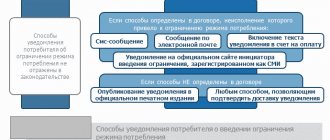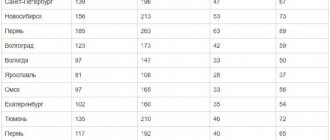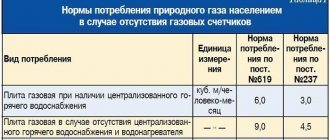What is a social norm
The social norm is the amount of electricity consumed per person, approved at the legislative level.
Payment for electricity within the standard is carried out at a reduced tariff. For spending more, the consumer pays more.
The authorities of the constituent entities of the Russian Federation are given the right to independently determine the norm of energy consumption, in accordance with local conditions. But the upward deviation should not exceed 40% of the established baseline.
Issues related to the calculation of standards and electricity consumption by the population are regulated by Government Decree No. 614, federal laws No. 35-FZ of February 21, 2003 and No. 261-FZ of November 23, 2009, and resolutions of local authorities.
Established indicators and factors influencing the value of the standard
Taking into account the conditions for calculating standards, it is more profitable for the consumer to pay for the electricity used according to the readings of the installed meter. In this case, payment is made for the resources actually used, without overpayment, taking into account the increasing coefficients included in the calculation methodology.
However, the installation of electricity meters is not possible for all consumers due to the lack of technical capabilities due to the deterioration of fixed assets in residential buildings and the unsatisfactory condition of networks. Sometimes consumers do not want to voluntarily install individual meters.
In this situation, payment is made according to calculated standards, depending on the following factors:
- residential and non-residential area of the apartment;
- the number of people registered in the living space;
- housing accessories to apartment or private buildings;
- using an electric oven for cooking;
- heating method;
- finding housing in a city or rural area.
These standards were calculated empirically on the basis of actually measured indicators for groups of consumers divided into categories for the country as a whole. Regional authorities are given the right to adjust standards in accordance with local conditions that affect the cost of supplying energy resources. However, the deviation upward from federal standards should not exceed 40%.
We recommend: How much electricity does a heated floor consume?
The maximum monthly norms per person approved in the regions, depending on the use of a gas or electric stove, respectively, are (in kWh):
- for single citizens living in a one-room apartment - from 81 to 185 or from 108 to 263;
- families living in similar conditions - from 28 to 63 or from 37 to 89.
Consumption standards
The norms are calculated taking into account the following additional circumstances:
- for residents of rural areas, the indicators are assigned higher by 90 kWh, due to the need to use energy resources in household farming;
- single pensioners, in the absence of an electric meter, which is not installed for valid reasons beyond the control of the consumer, pay for electricity according to the social standard established by the minimum consumption limit;
- For a dacha household with a centralized power supply without an installed individual metering device, the fee is set according to the standards per person.
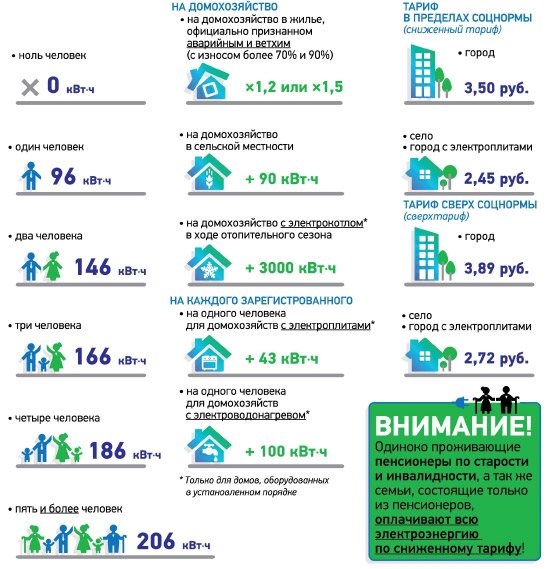
Electricity consumption standards for special cases
More details about the value of the established standards are set out in the resolutions of local authorities.
Why was the indicator introduced?
The state's goal is to encourage consumers to use electricity economically. Those who do not intend to reduce volumes will be forced to pay a higher price for the service. As a result, a private owner buys electricity for little money due to the fact that the business pays for the resource at an inflated rate.
Currently, citizens pay for energy consumption one and a half to two times lower than enterprises. For households that do not exceed the limits of the social norm, the tariff reduction may be 3-10%.
Size of social norms
What should be the standard for electricity consumption in 2020? The average rate cannot be set the same everywhere. Many factors influence the volume of consumption.
Where there is natural gas, less electricity is wasted. In northern cold areas it is needed more. The equipment of houses with electric boilers, elevators, and electric furnaces is taken into account. The norm for an apartment with a gas stove is less than for an apartment with an electric stove. It matters whether the household is located in a city or a village.

For apartment buildings, consumption standards depend on:
- square meters of residential apartment;
- power consumption of devices;
- number of apartments;
- number of rooms in the apartment;
- the number of registered residents in each apartment.
If for a single person the norm for electricity consumption is 96 kWh, then for a family of two people it is 156 kWh, and in a household of 3 people the norm will be 206 kWh.
Additional terms accepted:
- for residents of rural areas an additional 90 kWh per month is provided;
- if no one is registered in the country house or only one person is registered, only one social norm will be highlighted;
- when installing a gas stove in a household, the consumption standard will decrease by 43 kWh per person;
- When installing an electricity meter during the heating season, an additional 3000 kWh is provided to the standard.
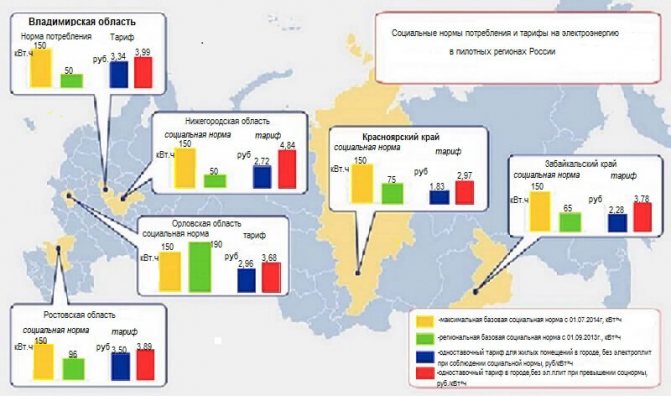
Thus, in 2020, the rate of electricity consumption per person (using a gas stove) was:
- in Moscow (Moscow region) – 80 kW*hour;
- St. Petersburg – 78 kW*hour;
- Nizhny Novgorod and Vladimir regions - 50 kW*hour;
- Trans-Baikal Territory – 65 kW*hour;
- Krasnoyarsk Territory – 75 kW*hour;
- Rostov region – 96 kW*hour;
- Oryol region - 190 kW*hour.
If the social norm is exceeded, the tariff increases on average by one and a half times. For example, in the Vladimir region, instead of 2.81 rubles per 1 kWh, you will need to pay 3.55 rubles, in Transbaikalia - 3.38 instead of 2.04 rubles.
Since January 2020, there has been an increase in electricity consumption standards by 10% compared to last year for citizens who have their own housing. Thus, the government decided to encourage people to purchase and install meters in their houses, apartments, and cottages.
It is planned to increase the social norm by a factor of 1.5 for:
- beneficiaries;
- large families;
- families with disabled people.
How is the electricity standard calculated?
Each region has its own standards for electricity consumption per person. You can find them on the website of your energy supply company. For residents of Moscow and the region, this is Mosenergosbyt.
If the homeowner does not have a meter installed, then the energy consumption is calculated according to the standard. The calculation formula is as follows:
If there is no electric meter or the meter readings are not transmitted by the tenant for more than six months, then the calculation will be carried out using a different formula:

The following standards apply in Moscow:
| Lonely citizen | Family, incl. and with disabled children | |
| with gas stove | 50 kW/h | 45 kW/h |
| with electric stove | 80 kW/h | 70 kW/h |
Payment according to the standard is made in the following cases:
- no electric meter installed;
- the metering device is installed, but not put into operation;
- metering node not found.
Electricity charging according to the standard is also possible if you have a meter. Such situations include the following:
- when the device is installed, but not accepted for accounting by the energy supply company;
- when the electric meter is broken and a new one is not installed.
Calculation procedure
If there is no meter, payment for consumed electricity is calculated using the formula:
P=L*N*T, where:
- P – final payment amount;
- L – number of people living in the apartment;
- N – the standard established in the region for one person;
- T – cost of 1 kW*hour according to the tariff plan.
In addition, in the absence of a meter, a multiplying factor is used.
The coefficient is not applied if the installation of a meter is not possible due to dilapidated housing, or if the networks are unsuitable for installing a control device.
Payment according to the standards can be calculated for consumption facilities with an installed electric meter if:
- the electric meter is faulty;
- there is no timely transmission of meter readings to the electricity supplier;
- control representatives are not given access to the meter;
- the device has been deliberately damaged.
According to current legislative norms, if within 3 months the consumer does not provide data on consumed electricity, the amount of payments is calculated based on the average indicators of the previous six-month period. From the fourth month, an invoice is offered for payment that corresponds to the tariffs and standards approved in the region.

In apartment buildings, payment for electricity is provided for the electricity supply (common building needs). In this case, a common meter is installed in the building, the readings from which, according to a certain form of calculation, are distributed to each apartment, taking into account the area of the home. If an individual meter is not installed, the amount will be calculated according to the standards of the local administration.
What is the standard for electricity consumption?
The calculation of electricity consumed by the population is regulated at the legislative level by several Federal laws and the Decree of the Government of the Russian Federation. The final amount in receipts for electricity largely depends on the established standards. Let us consider the main aspects of each law in more detail in order to have a complete understanding of this issue.
Government Decree No. 614
This document describes the rules for conducting a sample check to establish a standard, and also presents methods for carrying out calculations and collecting statistical information. In addition, categories of residential premises are indicated for which a fixed limit on electricity consumption is defined. If it is exceeded, the citizen is obliged to pay for services using increasing coefficients.
The meaning of the Resolution is that 70% of the population can meet the established standards without prejudice to themselves and their families, affecting the quality of life. The average figure is 70 kW/h per resident. This figure may be changed by the regional supplier, but such actions must be justified by statistical data for the region.
The fact is that our country is large and located in different climatic zones. Accordingly, electricity consumption changes, as it is used for lighting, heating and other needs.
Article 33 of Government Decree No. 614 of July 22, 2013 determines the amount of payment for consumed energy in the absence of electricity meters.

Thus, if the premises have the technical ability to install an electric meter, but the owner for some reason does not do this, then he will pay according to the standard and the coefficient that increases it. But if there is no technical capability and this is proven by documents of the established form, then payment will be made at fixed rates without increase. Therefore, if you do not have a meter installed, then for utility charges you need to refer to Article 33 of PP No. 614.
Important! The law says “reduction factor”. This term refers to a benefit. He increases the established tariff.
The Resolution also specifies the coefficients that influence the rate increase in the event of a breakdown of the electric meter. That is, if the consumer has not eliminated the problem by installing a new meter, then after 2 months the following coefficients will be applied to him:
- in the first six months – 0.9%;
- in each subsequent period of 6 months – 0.1.
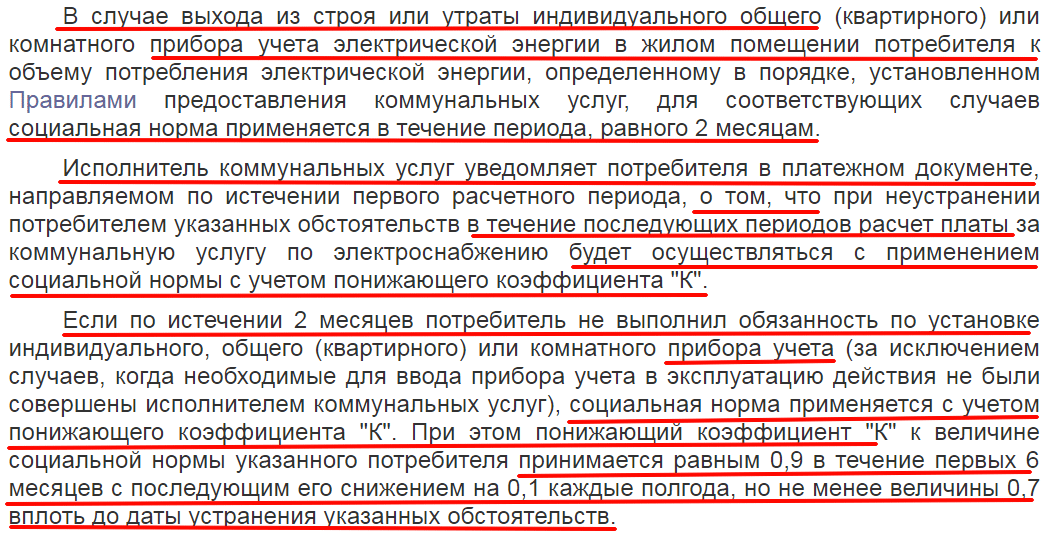
This law, in Article 38, states that the standard can be revised downward for some categories of citizens, but for this you need to submit an application to the energy supply company.
Recalculation is made within 10 working days. In this case, the period for the beginning of the emergence of rights to benefits is taken, but not more than 1 year.
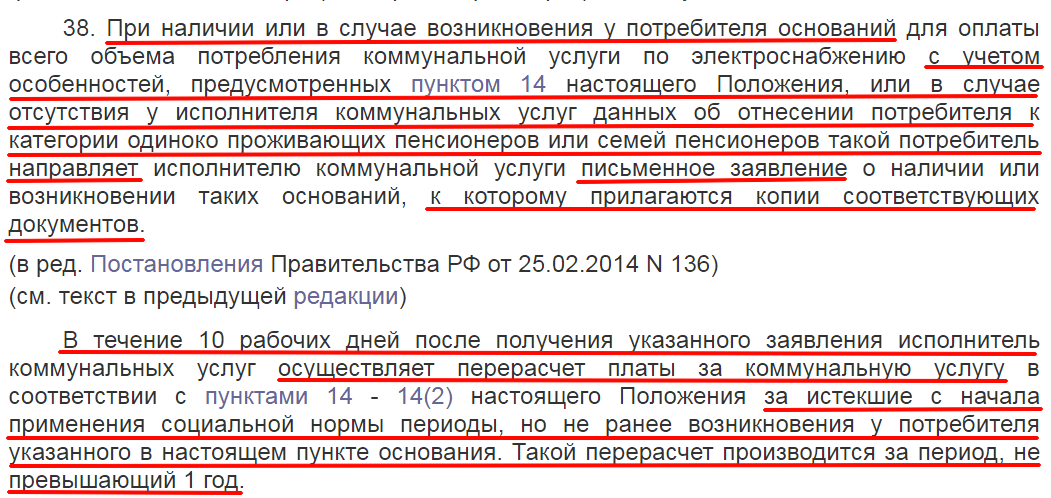
When grounds for receiving a benefit arise, the citizen must independently notify the executor, that is, the energy supply organization, about this.
Clause No. 14 established a preferential category of citizens who have the right to reduce the social norm using a coefficient of 1.5. At the same time, the amount of energy consumed should not exceed normal limits.

Previously, only pensioners living alone and their households were included in such categories. As can be seen from the law, the list has been expanded. Now most citizens can take advantage of electricity benefits.
Government Decree No. 614
Federal Law No. 35-FZ
This law is aimed at defining the powers of government bodies and regulating relations in the electricity sector. It also defines the rights and obligations of entities operating in the field of supply and generation of electricity, and consumers.
Federal Law-35
This law in Article 3 defines the basic concepts of the electric power industry:
- Billing period.
- Price and non-price zones.
- Guarantee supplier.
- Territorial network organization.
- Types of outages and much more.
The federal law is universal in nature, creates uniform rules for regulating relations and applies to both consumers and subjects of wholesale and retail energy markets.
Paragraph 5 of Article 23 talks about the principles and methods of price regulation. It is established that the supplier cannot change tariffs more than once a month. Therefore, energy sales companies change prices for supplied energy resources at the end of the year.
Article 38 regulates the relationship between electricity suppliers and consumers. Thus, it describes that the subject of the electric power industry is responsible for the quality of the supplied energy resource in accordance with technical regulations and other mandatory requirements.

In order to maintain the reliability of the energy resource supplied to the consumer, the law establishes that the rules for the technical operation of networks must be observed. It is mandatory to have a guaranteeing supplier responsible for the uninterrupted operation of the entire electricity supply scheme to the client.
Federal Law No. 261-FZ of November 23, 2009
This law is aimed at regulating energy supply relations and actions related to increasing energy efficiency. It was for this purpose that Law No. 261-FZ was created: to introduce and consolidate at the state level economic, legal and organizational incentives in the field of energy saving and energy efficiency.
Federal Law-261
As stated in Article 5, this law applies to:
- for activities where various types of energy resources are used;
- for energy resources and water supplied through the central water supply;
- on organizations related to public utilities, subjects of natural monopolies, the regulation of prices (tariffs) of which is carried out by the state of the Russian Federation;
- in the area of state defense and security.

Article 13 talks about the use of metering devices for consumed resources and the obligation to install metering systems in residential and non-residential premises. In this case, the equipment must comply with the requirements of the legislation of the Russian Federation. The following objects are not subject to the installation of electricity meters:
- dilapidated and unsafe housing;
- buildings listed for demolition;
- buildings awaiting major renovation.

Paragraph 9 of Article 13 states that organizations carrying out activities for the transfer of energy resources through general engineering networks are required to carry out work on the installation of metering devices. However, they cannot refuse citizens to enter into such an agreement if the client is served at their site. This paragraph also states that the price of work to install new control units is set by agreement of the parties, that is, free pricing takes place. If the client is provided with an installment payment plan, the interest on it should not exceed the refinancing rate of the Central Bank of the Russian Federation established on the day the contract was concluded. The exception is budget funds, for which an increased rate is allowed.
The social norm is discussed in paragraph 4 of Article 27, which specifies that it can only be established by state and local government bodies that have the authority to do so. In this case, the difference must be compensated to the energy sales company.

How to save money?
If no one is registered in the household, but there is a meter, you need to pay according to its readings. If there is no meter, the calculation is carried out according to the standards. But in this case, you will have to pay for a much larger amount of electricity than actually consumed.
Therefore, the first thing you need to do to save money is to install a meter.
Purchasing household appliances with economical energy consumption will help reduce costs. The international classification provides letter designations from A to G, where marking with the letter A means the most economical devices; there are additional even more economical classes A+, A++.
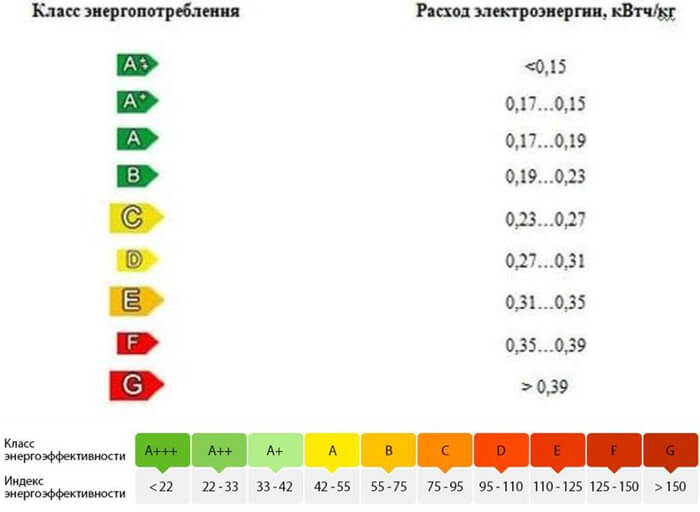
You can further reduce energy consumption:
- ensuring the tightness of rooms with air conditioners or electric heaters turned on;
- regularly removing scale from electric kettles, heating elements of water heaters, or using alternative sources of heating (boiling) water;
- following the rules for operating devices, for example, refrigerators and computers must be placed away from heating devices;
- using energy-saving lighting sources;
- by installing a two-tariff meter, including powerful electrical appliances at night, when payments for electricity are much lower.
An electric meter and the measures listed above will reduce the cost of electricity consumption.
For non-residential properties
Consumers of electricity in non-residential premises of apartment buildings pay for services in the same way as owners of residential premises.
The amount of payment depends on the group to which the user can be assigned:
- If this is the population and similar categories that use the resource for municipal household needs, payment is made at regulated prices and tariffs.
- In other cases, consumers pay for electricity at free, non-regulated prices, which are higher than the tariffs for the population.
Appendix 1 of the Decree of the Government of the Russian Federation No. 1178 dated December 29, 2011 provides a list of consumers belonging to the “population” group. This term refers to:
- providers of public services and landlords providing housing to citizens (social and other housing);
- SNT, dacha and garden plots of non-profit associations;
- legal entities purchasing electricity to support prisoners;
- consumers consuming electricity for utility and household needs of military settlements;
- religious organizations supported by donations from parishioners;
- energy sales companies purchasing resources for the population for household needs;
- non-profit associations of citizens purchasing electricity for the maintenance of non-residential premises not related to commercial activities (sheds, garages, cellars, boiler rooms).
If non-residential premises or territory are used for commercial activities and additional income is expected to be generated, free prices are used for groups in the category “other consumers”.
This category includes contracting firms involved in setting up construction sites and connecting power electrical equipment, without which the organization of work is impossible.
